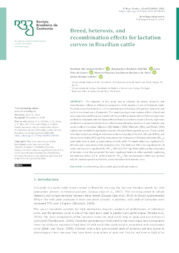Breed, heterosis, and recombination effects for lactation curves in Brazilian cattle.
Breed, heterosis, and recombination effects for lactation curves in Brazilian cattle.
Author(s): DALTRO, D. dos S.; PADILHA, A. H.; GAMA, L. T. da; SILVA, M. V. G. B.; COBUCI, J. A.
Summary: The objective of this study was to estimate the breed, heterosis, and recombination effects on different components of the lactation curve of Girolando cattle. The dataset used consisted of 12,121 purebred cows of Holstein (H) and Gyr (G) breeds, and six H×G crossbred cows (Girolando). The model used presents random effects of herd and cow, regression coefficient associated with linear effect of proportion of H breed, regression coefficient associated with the linear effect of heterosis between H and G breeds, regression coefficient associated with the linear effect of recombination between H and G breeds, and random effect of residual. Dijkstra?s (DJ), Nelder's (ND), Wilmink's (WL), and Wood's (WD) models were tested to fit production records of these different genetic groups. These models were then tested according to evaluation criteria of quality of fit (AIC, BIC, and RMSE), and the two best models (WD and WL) were chosen for estimation of 305-day milk yield (MY305), peak yield, time to peak, and persistency of milk yield. The breed effect was significant for all traits and components of the lactation curve. The heterosis effect was significant for all traits, and was more significant for MY305 (945.62±79.17 kg). Peak yield was the component of lactation curve that presented the most significant heterosis effect, partially explaining the heterosis effect (12 to 21%) found for MY305. The recombination effect was positive only for lactation period and time to peak of lactation in Girolando cows.
Publication year: 2021
Types of publication: Journal article
Unit: Embrapa Dairy Cattle
Observation
Some of Embrapa's publications are published as ePub files. To read them, use or download one of the following free software options to your computer or mobile device. Android: Google Play Books; IOS: iBooks; Windows and Linux: Calibre.
Access other publications
Access the Agricultural Research Database (BDPA) to consult Embrapa's full library collection and records.
Visit Embrapa Bookstore to purchase books and other publications sold by Embrapa.


